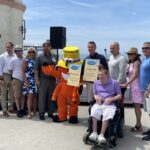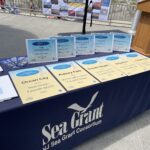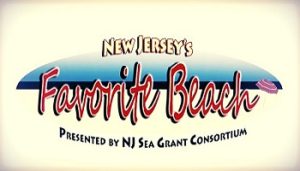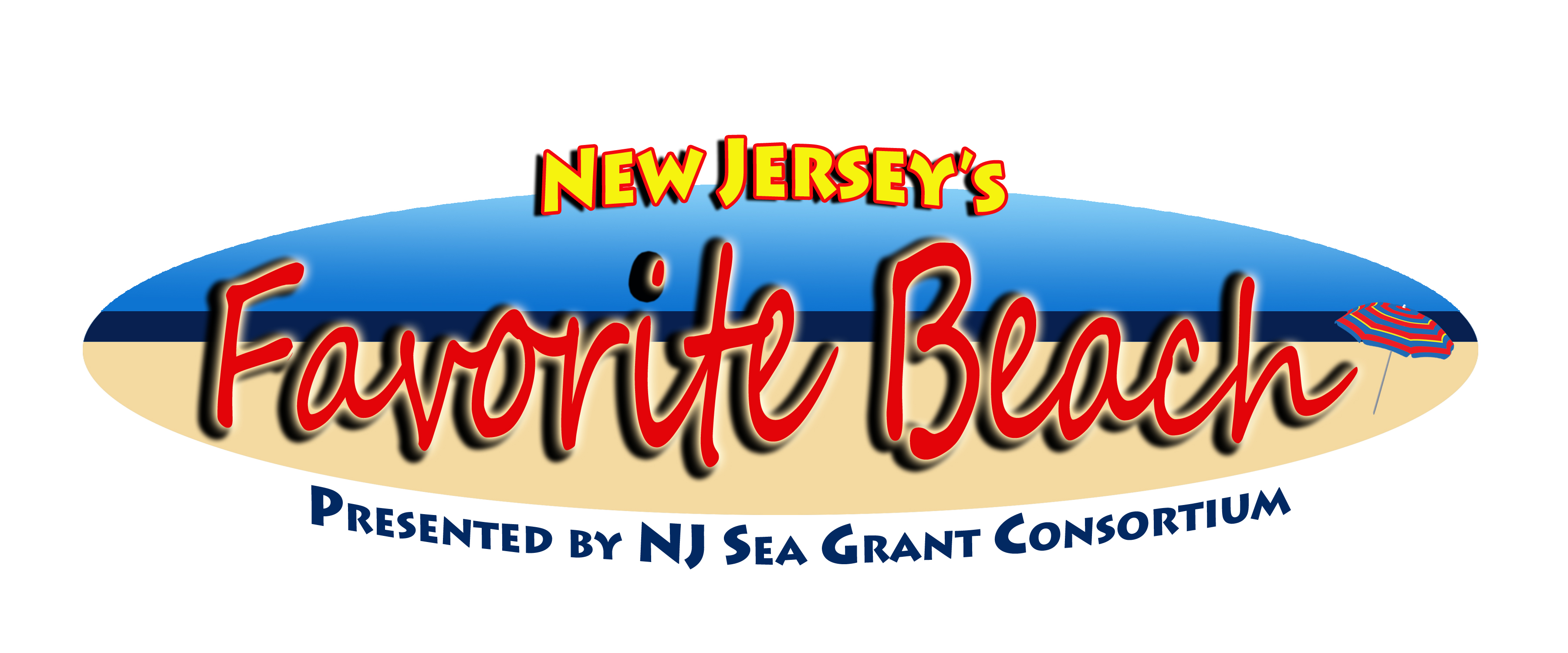Who’s up for a little marine-inspired scavenger hunt? Get ready for NJSGC’s “Sea Creatures in your Neighborhood” campaign! Here’s the plan.
- Draw and color a picture of NJSGC’s “animal of the week” (more information below).
- Include a “fun fact” about this creature.
- Hang your masterpiece in a front window, door, or yard. Snap a photo to post on social media with the hashtags #SeaCreaturesInYourNeighborhood, #NJSGC, and #SeaGrantSTEM. Be sure to include the name of your city or town. Feel free to send photos directly to NJSGC by contacting our Communications Specialist.
- On your next ride or walk around the neighborhood (while respecting the rules of social distancing), take pictures of any #SeaCreaturesInYourNeighborhood you notice. Or search and discover more virtually.
- Encourage friends and family to do the same and be sure to share your findings with us!
- Stay tuned for next week’s ”animal of the week” and repeat. Stay safe and have fun while learning about our favorite sea creatures found along the Jersey Shore!
- NJSGC will “spotlight” all submissions throughout Spring 2020.
__________________________
June 22, 2020
The Long-Clawed Hermit Crab (Pagurus longicarpus) – please use this template for guidance.
Have you ever walked through a shallow, intertidal beach and noticed a small, dark object moving along the sandy bottom? If so, chances are that you’ve seen a long-clawed hermit crab, one of many marine crustaceans found along the Jersey shore. A close relative of lobsters, long-clawed hermit crabs are invertebrates with exoskeletons that shed in order for the animal to grow. Like lobsters, long-clawed hermit crabs have two chelipeds (claws). but instead are narrow and unequal in size, with the right one growing larger than the left. They have five pairs of legs and use the first three pairs for walking; the fourth and fifth pairs are small and modified to hold into the gastropod (snail) shell that they carry on their backs. Hermit crabs “wear” unoccupied gastropod shells to protect their soft, elongated abdomens and will change shells when they outgrow the current one.
Did you know…
1. Hermit crab eggs hatch into larvae, called zoea. After molting several times, the zoea become megalops which then develop into juveniles, which will then grow into adults.
2. Long-clawed hermit crabs are the ultimate recyclers because, as scavengers, they recycle energy back into the ecosystem.
3. Long-clawed hermit crabs can regenerate lost limbs when they molt.
Check out this cool video of a long-clawed hermit crab changing shells with anemones. And here’s another clip of hermit crabs living in aluminum cans.
June 5, 2020
The Atlantic Silverside (Menidia menidia) – please use this template for guidance.
The Atlantic Silverside is a resident species and is one of the most abundant fish found in NJ’s estuaries and nearshore habitats. They have long slender bodies that are grey-green above and pale colored below with a distinct silver band that runs along each side (giving it the name “silverside”). Silversides are small, growing only up to 6 inches in length, and can often be found schooling in shallow waters. Commonly called “spearing” or “shiners” by fishers that use them for bait, silversides are consumers in the marine food web because they feast on the tiny phytoplankton and zooplankton that drift with the currents. Their small mouths lack teeth and are positioned upwards at the end of their snouts so that they can grab food that floats or swims above them. Females are usually larger than males and during the spawning season (May, June, early July) will deposit egg clusters on sandy bottoms. Silversides are sensitive to fluctuations in salinity, dissolved oxygen, and temperature, so they are an important species in helping scientists study environmental change.

Did you know…
-
Atlantic silversides can live up to two years, but most only make it to one year.
-
Silverside eggs that hatch in cooler water will develop into females, and those that hatch in warmer water will develop into males.
-
Silversides are an important food source for other marine animals in the estuary, and are eaten by everything from bluefish and striped bass to sea birds and crabs.
May 22, 2020
The Laughing Gull (Leucophaeus atricilla) – please use this template for guidance.

“Memorial Day is the start of the beach season at the Jersey Shore, and no sound is more iconic to beachgoers than the call of the laughing gull (click on this link to hear one). Like many vacationers, laughing gulls are regular visitors to NJ’s beaches, marshes, and back bays throughout the summer and fall. These medium-sized birds are relatives to lesser black-backed and Bonaparte’s gulls, which they can be found in congregation with along coastal areas of NJ. Adults have black heads, thin white eye crescents, and red bills which make them easy to identify. If you notice a laughing gull extending and lowering its neck, calling, and then throwing its head backwards, it is displaying a threatening behavior and alerting other gulls to stay away. This is also an important reminder for all beachgoers to practice social distancing!”
Did you know…
– Laughing gulls are opportunistic feeders. They eat snails, insects, crabs, squid, garbage, and anything else they can get their beaks on – including the snacks they steal from your beach bag!
– During the spring nesting season, male and female laughing gulls build their nest together where the female will lay 2-4 brown with black-speckled eggs.
– The oldest known laughing gull lived to be 22 years old!
Check out this cool video – and happy Memorial Day weekend!
May 11, 2020
The Common Atlantic Octopus (Octopus vulgaris) – please use this template for guidance.
“In honor of Mother’s Day this past weekend, we would like to pay tribute to one of the most dedicated moms in the ocean, the octopus! The Common Atlantic Octopus can be found living in crevices and muddy bottoms of NJ’s coastal waters. This member of the Mollusk family has greyish-yellow or brownish-green smooth skin that can change with its surroundings, which helps it maintain its private lifestyle. Like all octopuses, it has 8 arm-like tentacles with suckers to capture its prey. When a female is ready to lay her eggs, she will find a hiding spot such as a hole or other hollow area that can be sealed off with rocks, shells, or debris. Inside she will lay thousands of eggs (up to 500,000!) and stitch them together in long braids that she will then attach to the walls of the den. In the 4-5 months that it takes for the eggs to hatch, the mother octopus never leaves the nest to feed. Instead, she will vigilantly care for her young by carefully blowing water with her siphon over the eggs to keep them clean and oxygenated and protecting them from predators. After her young have hatched and she has shuttled them out of their nest, she will finally venture out in a weakened state and give the ultimate gift – her life.”
Watch this cool video excerpt from PBS’ “Nature” show entitled Octopus: Making Contact where a teenager befriends this unique creature!
Did you know…
– Considered the smartest of all invertebrates thanks to their large brains, octopuses can recognize people and explore objects through play – even opening jars and locked boxes!
– Octopuses use their tentacles not only for touching but for tasting, too!
– The Common Atlantic Octopus can grow up to 3 feet and live for 2-3 years.
– As a mollusk, octopuses are related to clams and oysters, but they have no external or internal shell.
May 1, 2020
The Blue Claw Crab (Callinectes sapidus) – please use this template for guidance.
“Spring is a time that many land animals emerge from hibernation, and there are some similarities in the ocean. Although most marine organisms do not hibernate specifically, some (like the blue claw crab) spend the colder months buried in the ocean bottom in a dormant state. As the duration of sunlight increases and water temperatures rise in May, hungry blue crabs will emerge and swim to shallow bays and estuaries. Crabs are ambush predators and once close to shore they will lie in wait for their prey to swim or amble by. Eating clams, fishes, and other crabs cause these invertebrates to fatten and eventually molt as they outgrow their shells. It takes a few hours for the new shell to harden, and while it is “soft shell” a crab is vulnerable to predators. Therefore, blue crabs will once again bury themselves into the sandy shallow bottom until their shells can protect them.”
Did you know…
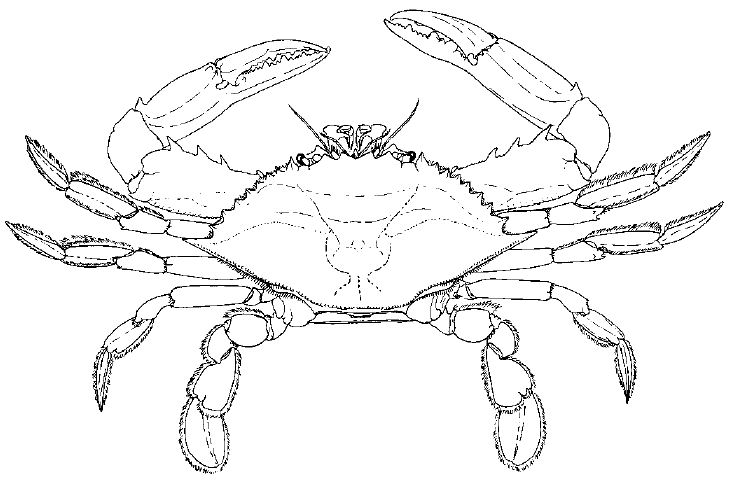
(Virginia Institute of Marine Science)
– Blue crabs are only one of two crab species in NJ that can swim – their 5th pair of (back) legs are modified to look like paddles, known as swimmerets.
– By looking at the abdomen, you can tell the gender of a crab: males are shaped like a golf tee, while females are shaped either like a triangle (immature) or rounded (mature). The large claws on mature females also have red tips.
– Although crabs spawn in the fall, females do not lay eggs until the spring, and they can lay up to 8 million at a time!
– Male blue crabs can live up to 3 years while females only live up to 2 years.
– Blue crabs feed by catching prey with their large claws and ripping their food apart to pass into their mouths.
Check out these cool videos!
Blue Crab Biology (University of Georgia Marine Extension and Georgia Sea Grant)
Local Crab Fishery (NJTV News)
April 24, 2020
In honor of NJSGC’s virtual launch of our “Sharks vs. Rip Currents” program…
The Atlantic Spiny Dogfish (Squalus acanthias) – please use this template for guidance.
“The Spiny Dogfish is a small shark found in abundance throughout the Garden State’s coastal waters. They are called ‘spiny’ because of the long spines located anterior to each of its two dorsal fins. These slim fish have long snouts and can grow up to four feet long. Like many sharks, Dogfish exhibit countershading, a type of camouflage that makes them effective predators. Dogfish are grey with white spots on their dorsal sides, and white below (on their ventral sides), making them difficult for prey swimming below them to see in the water. They are opportunistic feeders, which means that they will eat just about anything that they can catch, but they prefer crustaceans, squid, jellyfish, and other fish. While they are predators, Spiny Dogfish are also eaten by other animals higher up the food chain such as cod, hake, sharks, and even some whales. Dogfish, together with all types of sharks, are very important to the marine food web by helping to keep other species populations in balance.”
Did you know…
– Many people in European countries enjoy eating dogfish as part of a “fish and chips” meal.
– Females take up to 12 years to mature. When they do, they can give birth to an average of 6 live pups that take up to 24 months to gestate.
– The dogfish’s salt gland produces a substance called squalamine which scientists are studying as an anti-cancer agent.
– Spiny dogfish can live up to 40 years.
Check out this cool YouTube video on shark conservation.
April 17, 2020
The Osprey (Pandion haliaetus) – please use this template for guidance.
“Sometimes called “fish hawks,” ospreys live along waterways, lakes, and coastal waters in NJ and are typically spotted throughout Spring/Summer/Fall. These large birds feed almost exclusively on fish and can plunge feet-first into water to catch prey with their sharp talons. Identifiable characteristics of the osprey include: dark brown back, white front plumage, dark stripes on the head and tail, bent wings, and a high-pitched call.
Ospreys breed during this time of the year, and pairs can be found preparing for nesting. Nests need elevation to keep predators away, so observers are likely to find them in tall trees, chimneys, cell phone towers, or man-made nesting platforms. Ospreys use sticks, bark, seaweed, bones, and even beach towels to build their nests. Males collect nesting materials while the females arrange it. The couple will then use this same nest for years to come – eventually even ‘growing’ large enough for a human to sit in!”
Did you know…
– Ospreys mate for life, but males and females winter separately.
– Females are larger than males and have a dark feather “necklace” on their white chest.
– Females lay approximately three brown-spotted eggs in mid-April to early May, and chicks hatch in late May.
– Both osprey parents help feed and care for their young.
Thanks to the Conserve Wildlife Foundation of NJ, fans can now watch the live action Barnegat Light Osprey Cam.
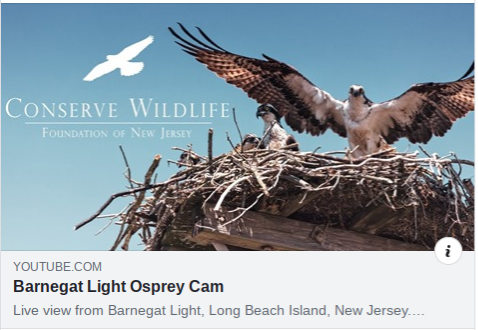
April 10, 2020 (Easter Edition)
“Egg case of the Jersey Shore,” the Clearnose Skate (Raja eglanteria). Please use this template for guidance.
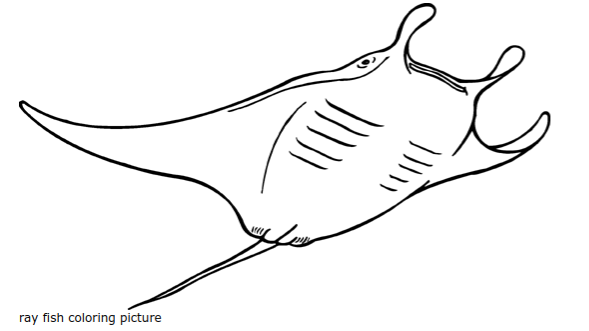
“Have you ever seen a dark brown, leathery pouch with “horns” on each end wash up on the beach? You might have heard it being called a “mermaid’s purse,” but it doesn’t come from a mermaid at all! They’re actually made by skates, a flat fish related to sharks. Female skates produce these casings when they lay their eggs and attach them to seaweed. The young grow and develop inside these egg cases, eventually breaking out and swimming away when they get to be about 6 inches long, which can take up to 3 months. As they mature, they feed on shrimp and other crustaceans, mollusks, and small fish.”
Did you know…
– Skates have cartilage instead of bones.
– Skates have flattened bodies, with their pectoral fins joined to their head and trunk, and a long tail trailing behind them.
– Skates can’t harm people with their tails because they do not have a venomous barb like stingrays do.
Additional Resources:
– Clearnose skate “walking” behavior (video)
– Little skate hatching (video)
APRIL 3, 2020
The Lined Seahorse (Hippocampus erectus) – please use this template for guidance.
“The lined seahorse is a resident of NJ’s shallow coastal waters and can be found living in eelgrass and seaweed beds. This fish has a horse-like head with a small mouth at the end that can quickly slurp up its favorite food – tiny crustaceans and other zooplankton. Its body is upright and covered in bony plates, and its long, finless tail curves inward to help it grasp objects. Seahorses grow to be 4-6 inches in length and can live to up to 4 years in the wild. They are vulnerable to pollution, loss of habitat, and overfishing (people like to collect them!) so protection is important so that they can thrive in their natural environment.”
Did you know…
– Seahorse fathers incubate the mother’s eggs and give birth to as many as babies!
– Seahorses mate for life, and pairs “dance” together every morning.
– Their color varies from light brown to almost black and it can change depending upon the background it is against.
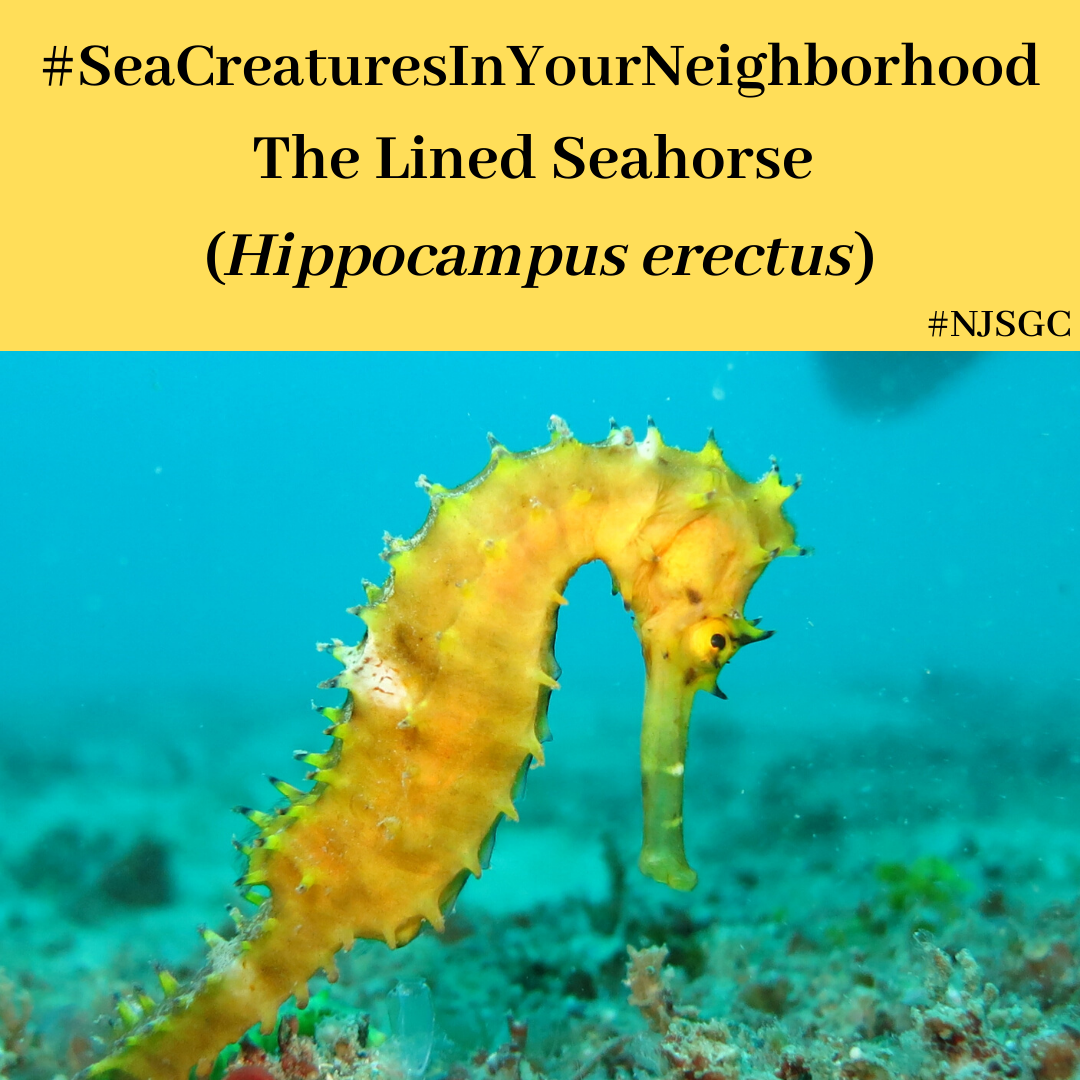
Additional resources:
The Maritime Aquarium
Chesapeake Bay Program
National Geographic
Scripps Institution of Oceanography
MARCH 27, 2020
NJSGC’s first pick of the week is the Eastern Common Sea Star. Feel free to use this template for guidance.
Did you know…
– Sea stars can regenerate their limbs if damaged or severed
– Sea stars eat their food outside of their body by turning their stomach inside out and extending it through their mouth
– Sea stars can live up to 35 years
– Or do your own research and get creative with the “fun fact!”
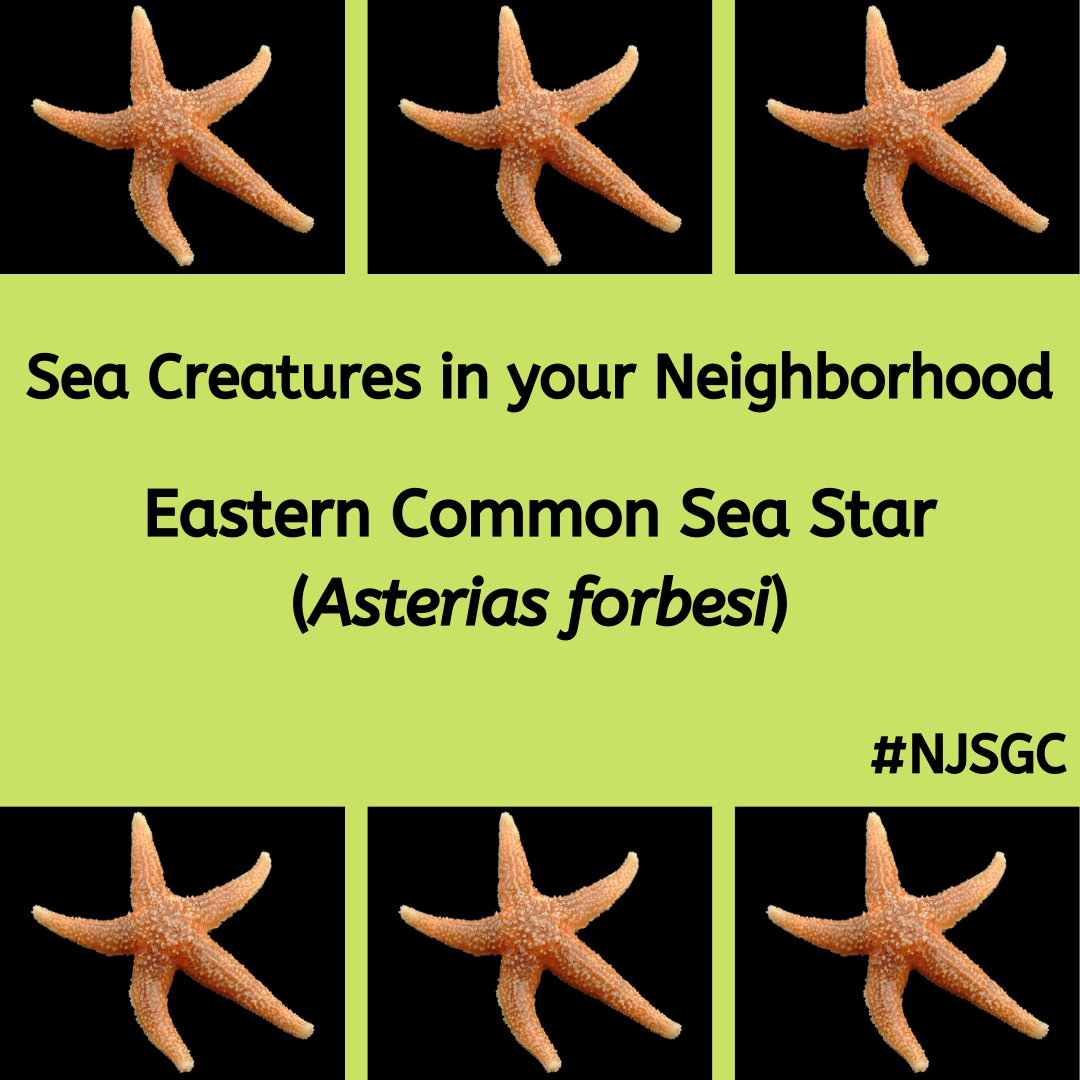
“The Eastern Common Sea Star is native to NJ’s coast and can be found in shallow rocky areas or sandy bottoms. Usually referred to as ‘starfish,’ they’re actually not fish at all. They’re echinoderms, belonging to a group of marine animals with tough, spiny skin and no bones (invertebrates). Sea stars have limbs (called rays) that radiate out from a central disc (radial symmetry) in multiples of five that help them move around and find food. They are carnivorous predators that love to eat snails, clams, oysters, mussels and barnacles. Sea star colors vary from olive, brown, yellow, orange, purple ,or red. They are related to sand dollars and sea urchins, both of which can also be found in coastal NJ waters.”
—
Stay tuned for next week’s creature!
Current Projects
2024-2026
Advancing an Online Calculator of Oyster Farms’ Water Quality Benefits to Foster Coastal Communities’ Environmental Stewardship [Omnibus]
Janine Barr
Rutgers University
Janine.barr@rutgers.edu
Determining whether surfclam subspecies can hybridize and evaluating their tolerance to ocean warming [Omnibus]
Dr. Michael Acquafredda
Haskin Shellfish Research Laboratory
Rutgers, The State University of New Jersey
michael.acquafredda@rutgers.edu
Distribution and sources of per- and polyfluoroalkyl substances in commercial coastal species in South New Jersey [Omnibus]
Thivanka Ariyarathna
Rowan University
Ariyarathna@rowan.edu
Assessing coastal invertebrate diversity and presence of fouling organisms through eDNA approaches with regards to offshore wind development [Omnibus]
Kirsten Monsen-Collar
Montclair State University
monsenk@montclair.edu
Unlocking Wind-Whale Co-Existence Through Artificial Intelligence [Omnibus]
Ahmed Aziz Ezzat
Rutgers University
aa2085@rutgers.edu
Freshwater mussel stocking to assess water quality benefits in nutrient-impaired ponds [Omnibus]
Martha Maxwell-Doyle
Partnership for the Delaware Estuary
mmaxwelldoyle@delawareestuary.org
Synthesis and assessment of potential green infrastructure retrofitting materials for adsorption and photocatalytic degradation of PFAS in stormwater runoff [Omnibus]
Dibyendu Sarkar
Stevens Institute of Technology
Dsarkar@stevens.edu
Listening In: Acoustic Monitoring for Improved Management and Protection in NJ Tidal Marshes [Omnibus]
LeeAnn Haaf
Partnership for the Delaware Estuary
lhaaf@delawareestuary.org
Expanding the New Jersey Apprenticeship in Shellfish Aquaculture Program (ASAP) [National Sea Grant College Program 2023-2025 Special Projects]
Diana Burich
New Jersey Sea Grant Consortium
dburich@njseagrant.org
Community Science to Address Microplastic Pollution in Environmentally Underserved Urban Watershed Communities in New Jersey and New York [National Sea Grant College Program 2022-2025 Special Projects]
Diana Burich
New Jersey Sea Grant Consortium
dburich@njseagrant.org
2022-2024
Filth Fly (diptera; Muscidae, Calliphoridae) Functional Biodiversity at Wastewater and Coastal Sites to Explore Impact on Water Associated Industries [NOAA Supplemental]
Michael Monzon
Rutgers, The State University of New Jersey
848-445-8416
mmonzone@njaes.rutgers.edu
Does the Surface Area of Edge Habitat Affect Community Structure Between Hard and Soft Sediments? [NOAA Supplemental]
Sophia Piper
Rutgers, The State University of New Jersey
sp2272@hsrl.rutgers.edu
It’s Not Just Oysters! The Importance of Biodiversity in Restoration Studies [NOAA Supplemental]
Allison Fitzgerald
New Jersey City University
afitzgerald@njcu.edu
Quantifying the Role of Vegetation Cover on Berm-Dune Geometry and Sedimentation Patterns in Long Branch, New Jersey [Omnibus]
Jorge Lorenzo-Trueba
Montclair State University
973-655-5320
lorenzotruej@monclair.edu
Testing the Influence of the Sedge Island Marine Conservation Zone on Blue Crabs [Omnibus]
Paul Jivoff
Department of Biology, Behavioral Neuroscience, and Health Sciences
Rider University
609-895-5421
pjivoff@rider.edu
Tropical Cyclone Impacts and Climate Resilience of Maritime Forests of New Jersey [Omnibus]
Nicole Davi
Department of Environmental Science
William Paterson University
973-720-3399
DAVIN@wpunj.org
Advancing Techniques to source track fecal Microbes in estuarine and coastal Waters to engage civic Scientists [Omnibus]
Nicole Fahrenfeld
Department of Civil & Environmental Engineering
Rutgers, The State University of New Jersey
848-445-8416
nfahrenf@rutgers.edu
Expanding Project SEA: Science, Education, and Action [Omnibus]
Lauren Madden
Elementary and Early Childhood Education
The College of New Jersey
609-771-3319
maddenL@tcnj.edu
Prioritizing Hazard Mitigation Investments for Equitable and Efficient Adaptation of Coastal Residential Communities [Omnibus]
William Payne
Edward J. Bloustein School of Planning and Public Policy
Rutgers, The State University of New Jersey
848-932-2370
will.b.payne@rutgers.edu
Predicting the response of salt marsh methane emissions to sea-level rise through field and numerical experiments [Omnibus]
Charles Schutte
School of Earth & Environment
Rowan University
856-256-5208
schutte@rowan.edu
Application of Ecoenzymes to Marine Oil Spill Mitigation [Omnibus]
Philip Sontag
Department of Environmental Sciences
Rutgers, The State University of New Jersey
philip.sontag@rutgers.edu
Combining eDNA with Acoustic and Video Data to Assess the Ecology of Submerged Coastal Structures [Omnibus]
Peter Straub
School of Natural Sciences & Mathematics
Stockton University
609-652-4556
Peter.Straub@stockton.edu
The Impact of Offshore Wind Farms on Local Physical Oceanography and Summer Flounder Distribution [Omnibus]
Ruo-Qian Wang
Department of Civil & Environmental Engineering
Rutgers, The State University of New Jersey
848-445-4288
rq.wang@rutgers.edu
Co-Treatment of Nitrogen and Phosphorus in Lignocellulosic Bioreactors: Control of Redox Conditions to Stimulate Denitrifiers and Polyphosphate Accumulating Organisms [National Sea Grant College Program 2020-2021 Special Projects]
Dr. Mathew Reid
Cornell University
mcmr239@cornell.edu
Innovative Inflow Distribution Design for Optimizing Hydraulic and Pollutant Removal Performance in Bioretention Systems [National Sea Grant College Program 2020-2021 Special Projects]
Dr. Michel Boufadel
Michel.Boufadel@NJIT.edu
Growing Trees by Growing Communities: Fostering Volunteer Tree Stewardship Through Community-Based Social Marketing [National Sea Grant College Program 2020-2021 Special Projects]
Dr. Mitchell Pavao-Zuckerman
MPZucker@UMD.edu
Removal of Nutrients and Pollutants from Stormwater Runoff through Green Infrastructure and Low Impact Development Optimization [National Sea Grant College Program 2020-2021 Special Projects]
Dr. Zhiming Zhang
zhangz@rowan.edu
Developing Low-Impact-Development Plans in Underserved Communities by Optimizing the Co-Benefits, Locations, and Characteristics of Green Infrastructures [National Sea Grant College Program 2020-2021 Special Projects]
Dr. Rayan Assaad
rayan.hassane.assaad@njit.edu
Continued Support for Expanding the Atlantic and Gulf Shellfish Seed Biosecurity Collaborative [Aquaculture NSI]
David Bushek
Rutgers, The State University of New Jersey
Haskin Shellfish Research Laboratory
bushek@hsrl.rutgers.edu
Enhancing Community Resilience Through Knowledge Co-Production on Sediment Transport and Bypassing Around Natural Tidal Inlet [NOAA Special Project: National Sea Grant College Program and US Coastal Research Program]
Dr. Kimberly McKenna
Kimberly.McKenna@stockton.edu
Co-Developing Ensemble Flood Forecast Products to Improve Communication and Preparedness Across Diverse Populations [NSGCP Special Project with NOAA/NOS/Disaster Preparedness Program]
Dr. Philip Orton
porton@stevens.edu
2020-2022
Optimizing Green Infrastructure and Low Impact Development to Mitigate Runoff and Pollution Impacts on Freshwater Systems [ National Sea Grant College Program 2020-2021 Special Projects]
Demographics, survivorship and post-released behavior of sharks captured in the land-based recreational shark fishery using fisheries-dependent data [Omnibus]
Keith Dunton
Monmouth University
kdunton@monmouth.edu
Developing and Implementing an Index to Assess the Resiliency of New Jersey’s Fishing Communities to Climate Change Impacts [Omnibus]
Lisa Auermuller
Jacques Cousteau National Estuarine Research Reserve
Rutgers, The State University of New Jersey
auermull@marine.rutgers.edu
Development of Point-of-Use Trace Metal Sensor and In-situ Sediment Extraction [Omnibus]
Philip Sontag
Rutgers, The State University of New Jersey
philip.sontag@rutgers.edu
“Local catch-of-the-day”: Connecting NJ seafood harvesters with culturally and economically diverse customers [Omnibus]
Cara Cuite
Rutgers, The State University of New Jersey
cuite@sebs.rutgers.edu
Mapping eastern black rail habitat to aid coastal conservation and climate resiliency planning [Omnibus]
Julie Lockwood
Rutgers, The State University of New Jersey
julie.lockwood@rutgers.edu
Physics-Based Assessment of Hurricane-Induced Wave Hazards Under Climate Change: Barrier Islands of New Jersey [Omnibus]
Reza Marsooli
Stevens Institute of Technology
rmarsool@stevens.edu
Project SEA: Science, Education, and Action [Omnibus]
Lauren Madden
The College of New Jersey
madden@tcnj.edu
Spatial and Temporal Patterns in Shorebird Distribution in Relation to Horseshoe Crab Eggs [Omnibus]
Daphne Munroe
Haskin Shellfish Research Laboratory
Rutgers, The State University of New Jersey
dmunroe@hsrl.rutgers.edu
Impacts of Oyster Aquaculture Gear on Submerged Aquatic Vegetation Recruitment and Recruitment Processes [Aquaculture Supplemental Grant]
Elizabeth Lacey
Stockton University
Elizabeth.Lacey@stockton.edu
Developing capacity for microplastics extraction from an archived New Jersey larval fish time series [Program Development Grant, Omnibus]
Thomas Grothues
Rutgers, The State University of New Jersey
Marine Field Station
grothues@marine.rutgers.edu
Interactive influences of Dermo disease and the Microbiome on Crassostrea virginica disease susceptibility and microbial dynamics [Program Development Grant, Omnibus]
David Bushek
Rutgers, The State University of New Jersey
Haskin Shellfish Research Laboratory
bushek@hsrl.rutgers.edu
Microplastic ingestion by New Jersey breeding seabirds [Program Development Grant, Omnibus]
John Wiedenmann
Rutgers, The State University of New Jersey
john.wiedenmann@rutgers.edu
Optimizing Atlantic striped bass aquaculture through the integration of duckweed and macroalgae [Program Development Grant, Aquaculture Supplemental]
Gal Hochman
Rutgers, The State University of New Jersey
gal.hochman@rutgers.edu
2018-2020
Impacts of thin layer sediment deposition on salt marsh ecosystems [Omnibus]
Dr. Kenneth W. Able, Principal Investigator
Department of Marine and Coastal Sciences
Rutgers, The State University of New Jersey
able@marine.rutgers.edu
Atlantic and Gulf Shellfish Seed Biosecurity Collaborative [Aquaculture NSI]
Dr. David Bushek, Principal Investigator
Haskin Shellfish Research Laboratory
Rutgers, The State University of New Jersey
bushek@hsrl.rutgers.edu
Establishing shellfish hatchery biosecurity certification standards to facilitate interstate transport of shellfish seed [Aquaculture NSI, 2018-2020]
Dr. David Bushek, Principal Investigator
Haskin Shellfish Research Laboratory
Rutgers, The State University of New Jersey
bushek@hsrl.rutgers.edu
River plumes as a control on microplastic entry into the food chain [Omnibus]
Dr. Nicole Fahrenfeld, Principal Investigator
Department of Civil & Environmental Engineering
Rutgers, The State University of New Jersey
nfahrenf@soe.rutgers.edu
Enhancing Bivalve Aquaculture through Species Improvement and Diversification [Aquaculture NSI, 2018-2020]
Dr. Ximing Guo, Principal Investigator
Department of Marine and Coastal Sciences
Rutgers, The State University of New Jersey
xguo@hsrl.rutgers.edu
Optimizing fishing regulations for New Jersey’s multi-species recreational bottom fishery to improve economic outcomes and angler satisfaction [Omnibus]
Dr. Olaf P. Jensen, Principal Investigator
Department of Marine and Coastal Sciences
Rutgers, The State University of New Jersey
ojensen@marine.rutgers.edu
Innovative Restoration Aquaculture of Freshwater Mussels in the Tidal Freshwater Zone of the Delaware Estuary Watershed for Water Quality Improvement [Aquaculture NSI]
Dr. Danielle A. Kreeger, Principal Investigator
Partnership for the Delaware Estuary, Inc.
Drexel University
dkreeger@delawareestuary.org
Measuring dune, beach, and nearshore response to an extreme event: Atlantic City, New Jersey [Omnibus]
Ms. Kimberly McKenna, Principal Investigator
Coastal Research Center
Stockton University
kimberly.mckenna@stockton.edu
Interactions among horseshoe crabs and intertidal oyster farms in the Delaware Estuary [Omnibus]
Dr. Daphne Munroe, Principal Investigator
Haskin Shellfish Research Laboratory
Rutgers, The State University of New Jersey
dmunroe@hsrl.rutgers.edu
Quantifying the effects of a changing climate on summer flounder recruitment [Omnibus]
Dr. Malin Pinsky, Principal Investigator
Department of Ecology, Evolution and Natural Resources
Rutgers, The State University of New Jersey
malin.pinsky@rutgers.edu
“Green” retrofit of stormwater BMPs for pollution prevention in urban coastal communities of New Jersey [Omnibus]
Dr. Dibyendu Sarkar, Principal Investigator
Department of Civil, Environmental, and Ocean Engineering
Stevens Institute of Technology
dsarkar@stevens.edu
Developing Indices of Vulnerability to Climate Change for Ground Fishing Communities in the Northeast [NOAA/National Marine Fisheries Service]
Dr. Kevin St. Martin, Principal Investigator
Department of Geography
Rutgers, The State University of New Jersey
kstmarti@geography.rutgers.edu
Engaging Undergraduates in Fisheries Population and Ecosystem Dynamics [National Sea Grant Special Competition]
John R. Wiedenmann, Principal Investigator
Dept. of Ecology, Evolution, and Natural Resources
Rutgers, The State University of New Jersey
john.wiedenmann@rutgers.edu
Assessing the Susceptibility of Atlantic Sea Scallops and Surf Clams to Ocean Acidification Using Glider-based Coastal Monitoring and Larval Transport Models [Mid-Atlantic Ocean, Coastal, and Estuarine Acidification Graduate Research Fellowship]
Elizabeth Wright-Fairbanks, Principal Investigator
Department of Marine and Coastal Sciences
Rutgers, The State University of New Jersey
elizabeth.wrightfairbanks@marine.rutgers.edu
2016-2018
Effects of Climate Change on Estuarine Fish Nurseries: Analysis and Implications from Decades-Long Time-Series
Dr. Kenneth W. Able
Department of Marine and Coastal Sciences
Rutgers, the State University of New Jersey
609-296-5260 x230
able@marine.rutgers.edu
Communicating About Flood Risks to Real Estate Market Segments in Coastal New Jersey
Dr. Clinton J. Andrews
Edward J. Bloustein School of Planning and Public Policy
Rutgers, The State University of New Jersey
848-932-2808
cja1@rutgers.edu
Dr. Robert Kopp
Department of Earth and Planetary Sciences
Rutgers, The State University of New Jersey
732-200-2705
robert.kopp@rutgers.edu
Understanding Risk Perceptions of Economic Development Officials in Coastal New Jersey Communities [PD Grant, 2016-2018]
Matthew Campo, Senior Research Specialist
Environmental Analysis and Communications Group
Rutgers, The State University of New Jersey
848-932-2704
matt.campo@ejb.rutgers.edu
Biochar-Coated Mulches for Alleviation of Stormwater N for Healthy New Jersey Coastal Waters [PD Grant, 2016-2018]
Dr. Yang Deng
Department of Earth and Environmental Studies
Montclair State University
973-655-6678
dengy@mail.montclair.edu
Understanding the Origins and Growth Rates of Juvenile Striped Bass in Small Rivers and Coastal Bays
Understanding the Origins and Growth Rates of Juvenile Striped Bass in Small Rivers and Coastal Bays, Part II
Dr. Olaf P. Jensen
Department of Marine and Coastal Sciences
Rutgers, the State University of New Jersey
410-812-4842
olaf.p.jensen@gmail.com
Protecting Jersey Shore Residential and Ecological Communities by Changing the Culture of Beach Management
Dr. Jay Kelly
Environmental Sciences
Raritan Valley Community College
908-526-1200 x8531
jkelly@raritanval.edu
Managing for Biodiversity and Blue Carbon in the Face of Sea-Level Rise and Barrier-Island Migration [Mid-Atlantic collaboration]
Dr. Jorge Lorenzo-Trueba
Assistant Professor, Earth and Environmental Studies
Montclair State University
973-655-5320
lorenzotruej@mail.montclair.edu
Identifying the Impacts of Commercial Oyster Aquaculture on Foraging Behavior of Red Knots in Delaware Bay
Dr. Brooke Maslo
Ecology, Evolution and Natural Resources
Rutgers, The State University of New Jersey
848-932-5572
brooke.maslo@rutgers.edu
Surf Clam Nursery and Culture Trials: New Species Development for New Jersey Shellfish Farms
Dr. Daphne Munroe
Haskin Shellfish Research Laboratory
Rutgers, The State University of New Jersey
856-785-0074 x 4325
dmunroe@hsrl.rutgers.edu
Diversifying Shellfish Aquaculture in New Jersey [Aquaculture NSI, 2016-2018, extension]
Dr. Daphne Munroe
Haskin Shellfish Research Laboratory
Rutgers, The State University of New Jersey
856-785-0074 x 4325
dmunroe@hsrl.rutgers.edu
At Risk: Healthy Coastal Ecosystems and Resilient Communities and Economies in an Era of Climate Change: A Balanced Approach to Protecting People, Property and Nature in Historic Greenwich Township, New Jersey
Dr. Colette Santasieri
Policy and Planning Innovation for Civil Infrastructure and Environment
New Jersey Institute of Technology
973-642-4165
santasieri@njit.edu
A Model-Data Synthesis of the Status and Trends of New Jersey’s Coastal Wetlands for Sea Level Rise Planning
Dr. Elizabeth Watson
Patrick Center for Environmental Research
Academy of Natural Sciences
Department of Biodiversity, Earth & Environmental Sciences
Drexel University
215-299-1109
elizabeth.b.watson@drexel.edu
2014-2016
OMNIBUS:
Advancing Eastern Oyster Aquaculture through Marker-assisted Selection
Dr. Ximing Guo, Principal Investigator
Haskin Shellfish Research Laboratory
Rutgers- IMCS
856-785-0074 x 4324
xguo@hsrl.rutgers.edu
Facilitating Natural Dune Building
Dr. Nancy L. Jackson, Principal Investigator
Center for Natural Resources Development and Protection
New Jersey Institute of Technology
973-596-8467
nancy.jackson@njit.edu
Development of Historically-Calibrated Sea Level Rise Projections for Risk Management Along the New Jersey Shore
Dr. Robert E. Kopp, Principal Investigator
Department of Earth and Planetary Sciences
Rutgers, The State University of New Jersey
732-200-2705
robert.kopp@rutgers.edu
Enhancing the Effectiveness of Decision Support Tools for Coastal Resilience
Dr. Richard G. Lathrop
Center for Remote Sensing and Spatial Analysis
Department of Ecology, Evolution and Natural Resources
Rutgers, The State University of New Jersey
848-932-1580
lathrop@crssa.rutgers.edu
Development of Climate Change Adaptation Elements for Municipal Land Use Plans
Dr. Karen W. Lowrie
Bloustein School of Planning and Public Policy
Rutgers, The State University of New Jersey
848-732-2708
klowrie@rutgers.edu
Assessing the Impacts of Connectivity on Coral Reef Metacommunity Dynamics in the Coral Triangle [NMFS-SG Fellowship, 2014-2018, extension]
Lisa C. McManus, Fellow [Co-Project Leader]
Ecology and Evolutionary Biology
Princeton University
954-232-3474
lisacm@princeton.edu // lisa.c.mcmanus@rutgers.edu
Dr. Simon A. Levin [Project Leader]
Professor, Ecology and Evolutionary Biology
Princeton University
609-258-6880
slevin@princeton.edu
Genetic Monitoring to Improve Fish Stock Assessments
Dr. Malin Pinsky
Department of Ecology, Evolution and Natural Resources
Rutgers, The State University of New Jersey
848 -932-8242
malin.pinsky@rutgers.edu
Green Technology for Nutrient and Metals Reduction in New Jersey Coastal Waters
Dr. Dibyendu Sarkar
Department of Earth and Environmental Studies
Montclair State University
973-655-7273
sarkard@mail.montclair.edu
An Evaluation of Data-Poor Stock Assessment Methods Using Data-Rich Stock Assessments from RAM Legacy Stock Assessment Database [NMFS-SG Fellowship, 2013-2017, extension]
Christopher M. Free, Principal Investigator
Department of Marine and Coastal Sciences
Rutgers, The State University of New Jersey
848-932-4026
cfree14@gmail.com
Dr. Olaf P. Jensen [Principal Investigator]
Department of Marine and Coastal Sciences
Rutgers, the State University of New Jersey
410-812-4842
olaf.p.jensen@gmail.com
Determining Sustainable Catch Limits for Data-Poor Fisheries in New Jersey
Dr. John Wiedenmann, Principal Investigator
Rutgers – IMCS
631-513-8748
john.wiedenmann@gmail.com
MID-ATLANTIC REGIONAL/PROGRAM DEVELOPMENT:
Evaluation of Climate Resilient Stormwater Management Practices for the Mid-Atlantic Region
Dr. Christopher Obropta , Co-Investigator
Rutgers Cooperative Extension Water Resources Program
Rutgers, The State University of New Jersey
obropta@njaes.rutgers.edu
Amanda Rockler and Jennifer Dindinger, Principal Investigators
Maryland Sea Grant Extension
Understanding the Impacts of Climate Change on the Distribution, Population Connectivity, and Fisheries for Summer Flounder in the Mid-Atlantic
Dr. Malin Pinsky, Principal Investigator
Rutgers- IMCS
848-932-8242
malin.pinsky@rutgers.edu
AQUACULTURE NATIONAL STRATEGIC INVESTMENT (NSI):
Minimizing Risks of Vibrio Bacteria in Farm-Raised Oysters Grown in Mid-Atlantic Intertidal Environments
Dr. David Bushek
Haskin Shellfish Research Laboratory
Rutgers, The State University of New Jersey
856-785-0074
bushek@hsrl.rutgers.edu
COASTAL COMMUNITIES CLIMATE ADAPTATION INITIATIVE NSI:
Collaborative Climate Adaptation Planning for Urban Coastal Flooding
Dr. Philip Orton
Stevens Institute of Technology
201-216-8095
philip.orton@stevens.edu
2012-2014
Omnibus Research
The Decline of Winter Flounder: Influences of Changes in Connectivity Between Estuaries and the Inner Continental Shelf
Dr. Kenneth Able
Rutgers University – IMCS
609-296-5260 ext. 230
able@marine.rutgers.edu
Dr. Thomas Grothues
Rutgers University – IMCS
609-296-5260 ext. 262
grothues@marine.rutgers.edu
Evaluating Ecological and Social Impacts of New Jersey Legislation Regulating Fertilizer Nitrogen Loads to Barnegat Bay – Little Egg Harbor Estuary by Using Isotopic Signatures, Seagrass Demographics, Social Response and Communications
Dr. Michael Kennish
Rutgers University – IMCS
609-296-5260 ext. 262
kennish@marine.rutgers.edu
Dr. Benjamin Fertig
Rutgers University – IMCS
301-785-7614
fertig@marine.rutgers.edu
The Influence of Estuary Geomorphology on Accretion of Coastal Wetlands: A Potential for Priority Planning for New Jersey’s Coastal Areas Vulnerable to Sea Level Rise
Dr. David Velinsky
Academy of Natural Sciences of Drexel University
215-299-1147
velinsky@ansp.org
Dr. Tracy Quirk
Academy of Natural Sciences
215-299-1109
quirk@ansp.org
Economic Vulnerability to Climate Change on the Jersey Shore: Promoting Adaptation, Resilience and Sustainability in Coastal New Jersey
Dr. Robin Leichenko
Rutgers University
848-445-4056
rleichen@rci.rutgers.edu
Economic Vulnerability to Climate Change in Coastal New Jersey: A Stakeholder-Based Assessment. World Scientific, 2014
Dr. Richard Lathrop
Rutgers University
732-932-1580
lathrop@crssa.rutgers.edu
Development Research
Comparative Analysis of Bivalve Clearance Rates for Restoration Management
Dr. David Bushek
Rutgers University – Haskin Shellfish Research Laboratory
856-785-0074 ext. 4327
bushek@hsrl.rutgers.edu
Developing the Sampling Protocols and Competencies Needed to Monitor Effectiveness of a Rain Garden Designed for Nitrogen Removal
Dr. Louise Wootton
Georgian Court University
732-987-2349
woottonl@georgian.edu
Past Research Projects
The list below represents all research projects funded by the New Jersey Sea Grant Consortium from 1998 through 2010. If you’re interested in obtaining more information about a specific project and no link is available, please contact the researcher directly.
2010 – 2012 | 2008 – 2010 | 2006 – 2008 | 2004 – 2006 | 2002 – 2004 | 2000 – 2002 | 1998 – 2000
For information about research projects funded prior to 1998, please contact NJSGC Communications at 732-872-1300 ext. 18.
2010-2012
Omnibus Research
Meteorological modulation of the exchange between Raritan Bay and the Coastal Ocean – R/6010-0013
Dr. Robert Chant
Rutgers, The State University of New Jersey
732-932-6555 x544
chant@marine.rutgers.edu
Reducing uncertainty in stock-recruitment relationships and fishery reference points using Bayesian meta-analysis – R/6010-0011
Dr. Olaf Jensen
Rutgers, The State University of New Jersey
732-932-6555
olaf.p.jensen@gmail.com
Assessing plant performance of ‘Cape’ American Beachgrass, Ammophila breviligulata, against local Beachgrass ecotypes – R/6010-0030
Dr. Michael Peek
William Paterson University
973-720-2247
peekm@wpunj.edu
Collection of Sex-Ratio Data for Summer Flounder Landings: Commercial and Recreational – R/6010-0012
Dr. Eric N. Powell
Rutgers, The State University of New Jersey, Haskin Shellfish Research Laboratory
856-785-0074 x4309
eric@hsrl.rutgers.edu
Development Research
Underwater survey and mapping of temperate artificial and natural reef habitats for modeling of productivity and trophic linkage to black sea bass and tautog fisheries
Dr. Peter Straub
Richard Stockton College
609-652-4556
pete.straub@stockton.edu
Assessing Impacts of Catch and Release Practices on Striped Bass (Morone saxatilis) Implications for Conservation and Management
John Tiedemann
Monmouth University
732-263-5545
jtiedema@monmouth.edu
2008-2010
Omnibus Research
Habitat dynamics of adult winter flounder: Connectivity between estuaries and inner continental shelves influence management of human impacts associated with dredging – R⁄6840–0002
Dr. Kenneth W. Able
Rutgers, The State University of New Jersey
609-296-5260 Ext. 230
able@marine.rutgers.edu
Shoreline stabilization and ecosystem enhancement of eroding marsh habitats using intertidal reef communities – R⁄6840–0003
Dr. David Bushek
Rutgers, The State University of New Jersey
856-785-0074 Ext. 4327
bushek@hsrl.rutgers.edu
Marker-assisted breeding technology for the eastern oyster – R⁄6840–0005
Dr. Ximing Guo
Rutgers, The State University of New Jersey
856-785-0074
xguo@hsrl.rutgers.edu
Evaluation of wind and wave processes critical in sustaining beach backshore environments – R⁄6840–0004
Dr. Karl Nordstrom
Rutgers, The State University of New Jersey
732-932-6555
nordstro@marine.rutgers.edu
An unwelcome guest: Is the presence of the invasive swim bladder parasite, Anguillicola crassus, influencing American eel (Anguilla rostrata) recruitment in New Jersey estuaries? – R⁄6848–0001
Dr. Mark Sullivan
The Richard Stockton College of New Jersey
609-626-3575
mark.sullivan@stockton.edu
Assessing the impact of the invasive Asiatic sand sedge, Carex kobomugi, on coastal dune communities in New Jersey. – R⁄6847–0001
Dr. Louise Wootton
Georgian Court University
732-987-2349
woottonL@georgian.edu
Development Research
System Dynamic Model Development for Passaic River Watershed Sustainability and Environmental Management Study
Dr. Huan Feng
Montclair State University
973-655-7549
fengh@mail.montclair.edu
Sub-lethal effects of contaminants on ontogeny of larval fishes: effects of changes in morphology and behavior on predation risk
Dr. Ursula A. Howson
Monmouth University
732-571-4432
uhowson@monmouth.edu
2006 – 2008
Omnibus Research
Slipping Away? What can glass eel stages tell us about the decline of the American eel (Anguilla rostrata) in the Middle Atlantic Bight estuaries? (R/6640-002)
Dr. Kenneth Able
Rutgers University
609-296-5260 ext. 230
able@marine.rutgers.edu
Assessing the population genetic structure of eelgrass (Zostera marina L.): implications for management and restoration of a coastal habitat (R/6642-001)
Dr. Paul Bologna
Montclair State University
973-655-4112
bolognap@mail.montclair.edu
Estimation of the Fall Velocity of Suspended Sediment in the Passaic River, NJ (R/6640-003)
Dr. David Fugate
Rutgers University
732-932-6555 ext. 233
fugate@marine.rutgers.edu
Phragmites australisinvasion and consequent effects on Fiddler Crab behavior and bioturbation (R/6646-001)
Dr. Michael Grove
Rowan University
856-256-4500 ext. 3579
grove@rowan.edu
Effects of Bulkheads on Horseshoe Crab Spawning and Egg Availability to Shorebirds (R/6644-001)
Ms. Nancy Jackson
New Jersey Institute of Technology
973-596-8467
jacksonn@njit.edu
Development of an HF Radar Derived Near-shore Wave and Current Product: Application to Rip Current Probability Along the New Jersey Coast (R/6640-001)
Dr. Josh Kohut
Rutgers University
732-932-6555 ext. 542
kohut@marine.rutgers.edu
Development Research
Isolation and Identification of Antimicrobial Compounds from Marine Epiphytic Bacteria (R/D-2005-1)
Dr. John Berger
Montclair State University
973-655-7118
bergerj@mail.montclair.edu
Genetic Stock Assessment of NJ Bay Scallops using Microsatellite Primers (R/D-2005-2)
Dr. James Campanella
Montclair State University
973-655-4097
campanellj@mail.montclair.edu
State Policymaking Institutions and Managing Biodiversity in Delaware Bay (R/D-2005-3)
Dr. Maurie Cohen
New Jersey Institute of Technology
609-596-5281
mcohen@adm.njit.edu
Modeling the Sensitivity of Acoustic Telemetry Gate Escapement to Seven User-defined Variables (R/D-6605-0002)
Dr. Thomas Grothues
Rutgers University
609-296-5260 ext. 262
grothues@marine.rutgers.edu
Root Dynamics and Population Performance in American Beachgrass, Ammophila breviligulata (R/D-2005-6)
Dr. Michael Peek
William Paterson University
973-720-2247
peekm@wpunj.edu
Distribution of Corbicula fluminea in New Jersey (R/D-2005-4)
Dr. Robert Prezant
Montclair State University
973-655-5108
prezantr@mail.montclair.edu
Developing the Proficiency to Monitor PolyBrominated Diphenyl Ether (PBDE) Contamination Levels in Barnegat Bay (R/D-2005-5)
Dr. Andrew Weber
Georgian Court University
732-987-2367
weber@georgian.edu
Selectivity of Salinity, Municipal Sewage, Herbicides and Heavy Metals Toward the Development of Brown Tide Bloom (R/6605-0001)
Dr. Liping Wei
New Jersey Institute of Technology
973-596-5389
wei@adm.njit.edu
National Strategic Investment Grant (2007)
Validation of disease-resistance markers for marker-assisted selection in the eastern oyster
Dr. Ximing Guo
Rutgers, The State University of New Jersey
856-785-0074
xguo@hsrl.rutgers.edu
2004 – 2006
Omnibus Research
The Importance of Marginal and Restored Habitats to Horseshoe Crab Recruitment in Delaware Bay, NJ (R/F-2002)
Dr. Mark Botton
Fordham College
212-636-6327
botton@mary.fordham.edu
Determining the Potential for Horseshoe Crab Habitat Restoration Using Beach Nourishment (R/CZM-2004)
Dr. Nancy Jackson
New Jersey Institute of Technology
973-596-8467
nancy.jackson@njit.edu
Cumulative Effects and New Jersey Marine Fisheries (R/SLP-2004)
Dr. Bonnie McCay
Rutgers University
732-932-9153 ext. 314
mccay@aesop.rutgers.edu
Harmful Algal Blooms (HABs) in Coastal Waters of New Jersey and the Mid-Atlantic Region: Importance of Dissolved Organic Matter in Stimulating Growth (R/ES-2004)
Dr. Sybil Seitzinger
Rutgers University
732-932-6555 ext. 342
sybil@imcs.rutgers.edu
Environmental Effects on Gene Expression in Winter Flounder (R/D-2002-3)
Dr. Peter Straub
Richard Stockton College of NJ
609-652-4556
pete.straub@stockton.edu
Development Research
Genomic Taxonomy for Identifying Aquatic Insects (R/D-2004-1)
Dr. Carolyn Bentivegna
Seton Hall University
973-275-2113
bentivca@shu.edu
Effects of an Invasive Grass on Fiddler Crab Activity and Bioturbation in New Jersey Salt Marshes (R/D-2004-2)
Dr. Michael Grove
Rowan University
856-256-4500 ext. 3579
grove@rowan.edu
Identifying Chironomid Species from the Hackensack Meadowlands using Amplified Fragment Length Polymorphism (R/UG-2004-1)
Dr. Carolyn Bentivegna
Seton Hall University
973-275-2113
bentivca@shu.edu
Analysis of Rip Current Generation Along Stabilized Coastlines (R/D-2003-1)
Dr. Michael Bruno
Stevens Institute of Technology
201-216-5338
m1bruno@stevens-tech.edu
Using GIS to Integrate Pollution Data and Study Pollutant Source Function in the Passaic River System, NJ (R/D-2003-2)
Dr. Huan Feng
Montclair University
973-655-7549
fengh@mail.montclair.edu
Production and Evaluation of All-triploid and Disease-resistant Eastern Oysters for Aquaculture (R/OD-2003-1)
Dr. Ximing Guo
Rutgers University
856-785-0074 ext. 124
xguo@hsrl.rutgers.edu
Sustainable Development of Estuarine Shorelines-Linking Science with Local Decision-making to Manage Horseshoe Crab Populations in Delaware Bay (R/D-2004-3)
Dr. Nancy Jackson
New Jersey Institute of Technology
973-596-8467
jacksonn@njit.edu
The Effect of Commercial Fishing on the Population Structure and Reproductive Potential of the Blue Crab, Callinectes sapidus (R/D-2004-4)
Dr. Paul Jivoff
Rider University
609-895-5421
pjivoff@rider.edu
Spartina alterniflora and Phragmites australis as Habitat for the Ribbed Mussel, Geukensia demissa (Dillwyn) (R/D-2003-3)
Dr. Marion McClary
Fairleigh Dickinson University
201-692-2606
mcclary@fdu.edu
Restoration of Natural Landscapes on Shorefront Properties (R/D-2003-4)
Dr. Karl Nordstrom
Rutgers University
732-932-6555 ext. 502
nordstro@imcs.rutgers.edu
Elements as Tracers in Ear Otoliths and Soft Tissues of Bluefish Provide Information on Origin and Contaminant (R/D-2004-5)
Dr. William Saidel
Rutgers University
856-225-6336
saidel@crab.rutgers.edu
Optimization of Antioxidant Production by Dunaliella salina and Tetraselmis suecica (R/D-2004-6)
Dr. Dennis Shevlin
The College of NJ 609-771-2246
shevlin@tcnj.edu
Microarrays for the Study of Gene Expression in Winter Flounder (R/D-2003-5)
Dr. Peter Straub
Richard Stockton College of NJ
609-652-4556
pete.straub@stockton.edu
Are there Genetic Differences in Pristine versus Eutrophied Portions of Barnegat Bay? (R/UG-2004-2)
Dr. Louise Wootton
Georgian Court University
732-364-2200 ext. 349
woottonl@georgian.edu
Identification and Mapping of Oyster Genes Involved in Host-defense Against Dermo and MSX (R/OD-2003-2)
Dr. Ziniu Yu
Rutgers University
856-785-0074 ext. 140
carlzyu@hsrl.rutgers.edu
2002 – 2004
Omnibus Research
Assessing Sediment Transport and Restoration Potential on Developed Coastal Dunes (R/CZM-2002)
Dr. Karl Nordstrom
Rutgers University
732-932-6555 ext. 502
nordstro@imcs.rutgers.edu
Differential Identification of Fecal Escherichia coli (E. coli) in the Manasquan River Estuary by Multiple Antibiotic Resistance Testing and DNA Fingerprinting Analysis (R/ES-2002-1)
Dr. Michael Palladino
Monmouth University
732-263-5543
mpalladi@monmouth.edu
Uptake of Toxic Metals by Natural Phytoplankton Assemblages in the Mid-Atlantic Bight
(R/ES-2002-2)
Dr. Robert Sherrell
Rutgers University
732-932-6555 ext. 252
sherrell@imcs.rutgers.edu
The Production of Pleurocidin, a Natural Antimicrobial Peptide from Winter Flounder, in Genetically Engineered Microorganisms for Food Application (Phase I) (R/BT-2002)
Dr. Tung-Ching Lee
Rutgers University
732-932-9611 ext. 236
lee@aesop.rutgers.edu
Development Research
Evaluating Biomarkers for Genetic Diversity in Chironomids from Kearny Marsh, NJ (R/UG-2002-1)
Dr. Carolyn Bentivegna
Seton Hall University
973-275-2113
bentivca@shu.edu
Assessment of Climatic and Human Activities on Shoreline Change (R/D-2004)
Dr. Nancy Jackson
New Jersey Institute of Technology
973-596-8467
nancy.jackson@njit.edu
Modeling Autotrophic Denitrification Kinetics (R/UG-2002-2)
Dr. Kauser Jahan
Rowan University
856-256-5323
jahan@rowan.edu
Identifying and Claiming the Coastal Commons in Industrialized and Gentrified Places (R/SCS-2002-1)
Dr. Bonnie McCay
Rutgers University
732-932-9153 ext. 314
mccay@aesop.rutgers.edu
Environmental Knowledge of Commercial Fishermen and its Application to Fisheries Management (R/SCS-2002-2)
Dr. Bryan Oles
Rutgers University
732-932-8797
oles@aesop.rutgers.edu
Continued Studies: Model Development & Chemical Characterization of Bioavailable Nitrogen Loading to Coastal Ecosystems (R/ES-2002-3)
Dr. Sybil Seitzinger
Rutgers University
732-932-6555 ext. 342
sybil@imcs.rutgers.edu
2000 – 2002
Omnibus Research
Essential Fish Habitat on the Inner Continental Shelf (R/F-2001)
Dr. Kenneth Able
Rutgers University
609-296-5260 ext. 230
able@arctic.rutgers.edu
Triploid-tetraploid Technology for Hard Clam Aquaculture (R/BT-2001)
Dr. Ximing Guo
Rutgers University
856-785-0074 ext. 124
xguo@hsrl.rutgers.edu
The Role of Metallothioneins in Marine Trophic Transfer of Metals (R/E-2002)
Dr. Francois Morel
Princeton University
609-258-2416
morel@geo.princeton.edu
Model Development and Chemical Characterization of Bioavailable Nitrogen Loading to Coastal Ecosystems (R/E-2001)
Dr. Sybil Seitzinger
Rutgers University
732-932-6555 ext. 342
sybil@imcs.rutgers.edu
Development Research
Assessing Bay Scallop (Argopecten irradians) Populations Structure and Reproduction: Potential for Stock Enhancement in Barnegat Bay, NJ (R/D-2000)
Dr. Paul Bologna
Fairleigh Dickinson University
973-443-8758
bologna@fdu.edu
Assessment of Eelgrass, Zostera marina, Health and Biomass in Relationship to the Occurrence and Intensity of Brown-tide Events in Barnegat Bay, New Jersey (R/D-2001-1)
Dr. Paul Bologna
Fairleigh Dickinson University
Installation of a Coastal Monitoring Network at Long Branch, NJ (R/D-2001-3)
Dr. Michael Bruno
Stevens Institute of Technology
201-216-5338
m1bruno@stevens-tech.edu
Assessing Shore Protection on Delaware Bay Beaches to Restore Habitat for Horseshoe Crab Spawning and Egg Viability (R/D-2002-1)
Dr. Nancy Jackson
New Jersey Institute of Technology
973-596-8467
nancy.jackson@njit.edu
Effects of Waves and Currents on Horseshoe Crab Egg Density and Availability to Shorebirds on Sandy Estuarine Beaches in New Jersey and Delaware (R/D-2001-2)
Dr. Nancy Jackson
New Jersey Institute of Technology
973-596-8467
nancy.jackson@njit.edu
Control of Range Expansion and Habitat Use of the Invasive Green Crab, Carcinus maenas, by a Native Predator-a Case of Biotic Resistance? (R/D-2002-2)
Dr. Paul Jivoff
Rider University
609-895-5421
pjivoff@rider.edu
Pollution Effects on Gene Expression in Winter Flounder (R/D-2003)
Dr. Peter Straub
Richard Stockton College of NJ
609-652-4556
pete.straub@stockton.edu
Fiddler Crabs as ‘Ecological Engineers’ in Phragmites vs. Spartina Marshes (R/D-2002-4)
Dr. Peddrick Weis
UMDNJ- New Jersey Medical School
973-972-4409
weis@umdnj.edu
Assessment of Spread Rates of Carex kobomugi (R/EXT-2002)
Dr. Louise Wootton
Georgian Court College
732-364-2200 ext. 349
woottonl@georgian.edu
Community Structure and Detrital Dynamics in Zostera marina and Ruppia maritima Beds in Barnegat Bay, Implications for Essential Fish Habitat (R/D-2002-5)
Dr. Louise Wootton
Georgian Court College
732-364-2200 ext. 349
woottonl@georgian.edu
1998 – 2000
Omnibus Research
Molecular Characterization of American Oyster Chromosomes by Fluorescence In Situ Hybridization (B/T-9801)
Dr. Ximing Guo
Rutgers University
856-785-0074 ext. 124
xguo@hsrl.rutgers.edu
Dynamic Mixing Zone Analysis and Biological Study to Evaluate the Effects of Chlorinated Municipal Wastewater on the Marine Environment (R/M-9802b)
Dr. Richard Hires
Stevens Institute of Technology
201-216-5676
rhires@stevens-tech.edu
Development Research
Breeding, Evaluation and Molecular Analysis of Oyster Strains Selected for Resistance to MSX, Dermo and JOD (ORDP-29) (R/OD-2001)
Dr. Ximing Guo
Rutgers University
856-785-0074 ext. 124
xguo@hsrl.rutgers.edu
Cooperative Regional Oyster Selective Breeding Project (R/OD-9908)
Dr. Ximing Guo
Rutgers University
856-785-0074 ext. 124
xguo@hsrl.rutgers.edu
Effects of Climate Variability on the Prevalence and Intensity of Dermo and MSX in Eastern Oyster Populations (R/OD-9913)
Dr. Eric Powell
Rutgers University
609-785-0075 ext. 109
eric@hsrl.rutgers.edu


